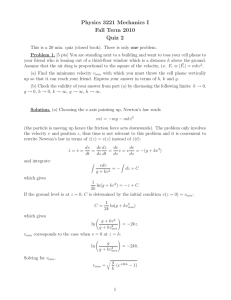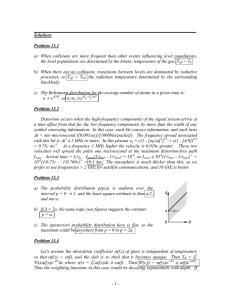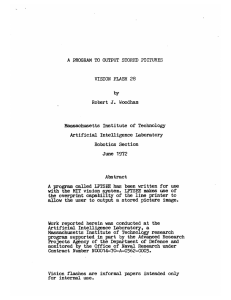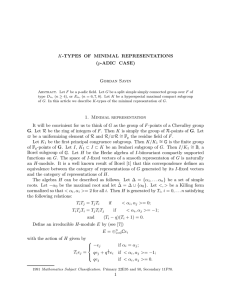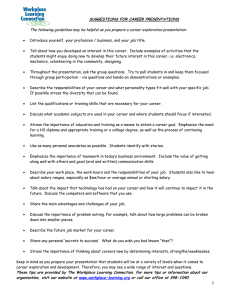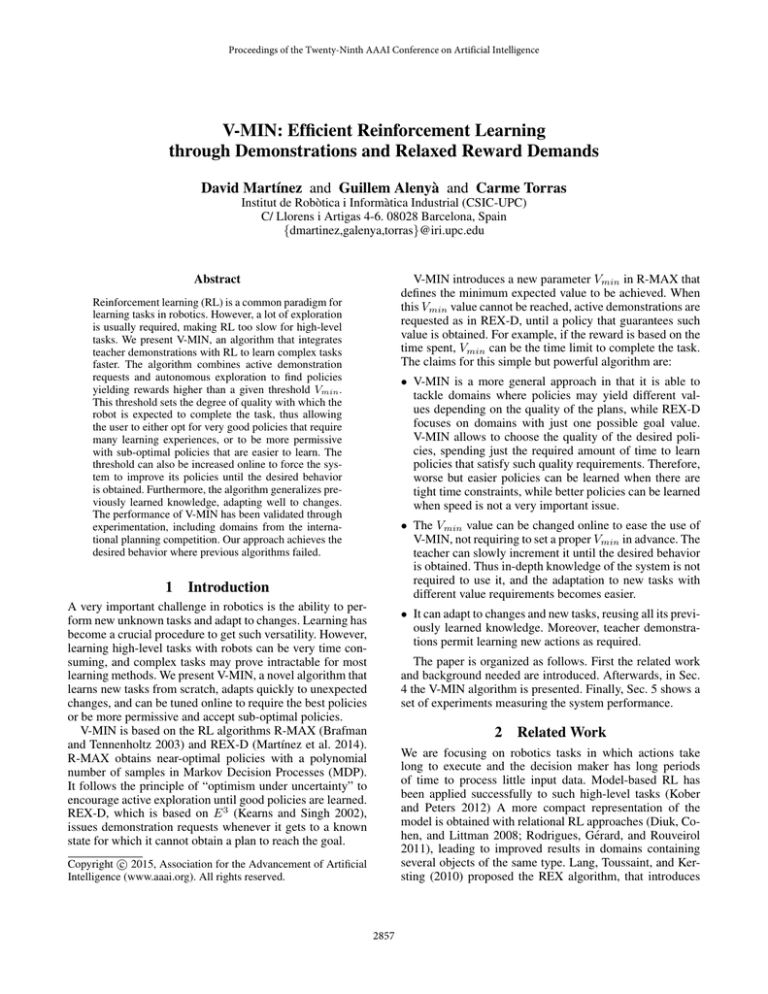
Proceedings of the Twenty-Ninth AAAI Conference on Artificial Intelligence
V-MIN: Efficient Reinforcement Learning
through Demonstrations and Relaxed Reward Demands
David Martı́nez and Guillem Alenyà and Carme Torras
Institut de Robòtica i Informàtica Industrial (CSIC-UPC)
C/ Llorens i Artigas 4-6. 08028 Barcelona, Spain
{dmartinez,galenya,torras}@iri.upc.edu
V-MIN introduces a new parameter Vmin in R-MAX that
defines the minimum expected value to be achieved. When
this Vmin value cannot be reached, active demonstrations are
requested as in REX-D, until a policy that guarantees such
value is obtained. For example, if the reward is based on the
time spent, Vmin can be the time limit to complete the task.
The claims for this simple but powerful algorithm are:
Abstract
Reinforcement learning (RL) is a common paradigm for
learning tasks in robotics. However, a lot of exploration
is usually required, making RL too slow for high-level
tasks. We present V-MIN, an algorithm that integrates
teacher demonstrations with RL to learn complex tasks
faster. The algorithm combines active demonstration
requests and autonomous exploration to find policies
yielding rewards higher than a given threshold Vmin .
This threshold sets the degree of quality with which the
robot is expected to complete the task, thus allowing
the user to either opt for very good policies that require
many learning experiences, or to be more permissive
with sub-optimal policies that are easier to learn. The
threshold can also be increased online to force the system to improve its policies until the desired behavior
is obtained. Furthermore, the algorithm generalizes previously learned knowledge, adapting well to changes.
The performance of V-MIN has been validated through
experimentation, including domains from the international planning competition. Our approach achieves the
desired behavior where previous algorithms failed.
1
• V-MIN is a more general approach in that it is able to
tackle domains where policies may yield different values depending on the quality of the plans, while REX-D
focuses on domains with just one possible goal value.
V-MIN allows to choose the quality of the desired policies, spending just the required amount of time to learn
policies that satisfy such quality requirements. Therefore,
worse but easier policies can be learned when there are
tight time constraints, while better policies can be learned
when speed is not a very important issue.
• The Vmin value can be changed online to ease the use of
V-MIN, not requiring to set a proper Vmin in advance. The
teacher can slowly increment it until the desired behavior
is obtained. Thus in-depth knowledge of the system is not
required to use it, and the adaptation to new tasks with
different value requirements becomes easier.
Introduction
A very important challenge in robotics is the ability to perform new unknown tasks and adapt to changes. Learning has
become a crucial procedure to get such versatility. However,
learning high-level tasks with robots can be very time consuming, and complex tasks may prove intractable for most
learning methods. We present V-MIN, a novel algorithm that
learns new tasks from scratch, adapts quickly to unexpected
changes, and can be tuned online to require the best policies
or be more permissive and accept sub-optimal policies.
V-MIN is based on the RL algorithms R-MAX (Brafman
and Tennenholtz 2003) and REX-D (Martı́nez et al. 2014).
R-MAX obtains near-optimal policies with a polynomial
number of samples in Markov Decision Processes (MDP).
It follows the principle of “optimism under uncertainty” to
encourage active exploration until good policies are learned.
REX-D, which is based on E 3 (Kearns and Singh 2002),
issues demonstration requests whenever it gets to a known
state for which it cannot obtain a plan to reach the goal.
• It can adapt to changes and new tasks, reusing all its previously learned knowledge. Moreover, teacher demonstrations permit learning new actions as required.
The paper is organized as follows. First the related work
and background needed are introduced. Afterwards, in Sec.
4 the V-MIN algorithm is presented. Finally, Sec. 5 shows a
set of experiments measuring the system performance.
2
Related Work
We are focusing on robotics tasks in which actions take
long to execute and the decision maker has long periods
of time to process little input data. Model-based RL has
been applied successfully to such high-level tasks (Kober
and Peters 2012) A more compact representation of the
model is obtained with relational RL approaches (Diuk, Cohen, and Littman 2008; Rodrigues, Gérard, and Rouveirol
2011), leading to improved results in domains containing
several objects of the same type. Lang, Toussaint, and Kersting (2010) proposed the REX algorithm, that introduces
c 2015, Association for the Advancement of Artificial
Copyright Intelligence (www.aaai.org). All rights reserved.
2857
where ar is the action, φr (χ) are the preconditions that define the context in which the rule is applicable, Ωr,i are the
effects defining the predicates that are changed in the state
with probability pr,i when the rule is applied, Ωr,0 is the
noisy effect that represents all other, unmodeled, rare and
complex effects, and χ is the set of variables of the rule. A
rule covers a state-action (s, a) pair when the rule represents
the action a and its preconditions are satisfied in the state
s. We represent a rule covering (s, a) with rs,a . Moreover,
when the reward is used as a function of a rule R(r), it refers
to the state-action pairs that the rule covers. A NDR rule represents one action, while each action may be represented by
several rules. Each state-action pair (s, a) is covered by just
one rule r as all the rules defining one action have disjoint
preconditions φra,i ∧ φra,j = ∅ ∀i, j | i 6= j.
A RL algorithm maximizes cumulative rewards, having
to balance between exploration (exploring the model to obtain better policies) and exploitation (choose actions to maximize the value function according to the current policy).
Lang, Toussaint, and Kersting (2012) proposed a contextbased density count function to handle the explorationexploitation dilemma. It takes advantage of the relational
representation and reduces the number of samples before
considering states as known by grouping them in contexts:
X
k(s, a) =
|E(r)|I(r = rs,a ),
(2)
relational generalizations in the exploration-exploitation
dilemma, minimizing the amount of exploration required.
Robotic tasks also face the problem of uncertainty in the
actions. Within the KWIK framework (Li et al. 2011) a
method to learn the action effects and probabilities has been
proposed (Walsh 2010). However, as the problem of learning action effects is NP (Walsh 2010), a large number of
samples is needed. More efficient heuristic algorithms exist,
such as TEXPLORE (Hester and Stone 2013) and the learner
proposed by Pasula, Zettlemoyer, and Kaelbling (2007), that
obtain suboptimal but good solutions. We will use Pasula et
al.’s learner, since it yields more compact and tractable models with relational rules, deictic references and noisy effects.
The integration of teacher demonstrations has already
been tackled within RL-like algorithms to improve the learning process. Meriçli, Veloso, and Akın (2012) presented an
algorithm where the teacher issues corrective demonstrations if the robot doesn’t perform as desired. In (Walsh
et al. 2010), the teacher reviews the planned actions, and
whenever they are not optimal, a demonstration is shown.
In these approaches the teacher has to intervene to improve
the robot behavior. In comparison, our algorithm actively requests demonstrations when needed, releasing the teacher
from having to monitor the system continuously.
Active demonstration requests have been included in algorithms with confidence thresholds (Grollman and Jenkins
2007; Chernova and Veloso 2009), which request demonstrations for a specific part of the state space whenever
the system is not sure about the expected behavior. Our
approach combines active demonstration requests with autonomous exploration. As teacher time is considered to be
very valuable, demonstration requests should be limited and
replaced with exploration whenever possible.
3
r∈Γ
where |E(r)| is the number of experiences that cover the
rule r with any grounding, and I() is a function that takes
the value 1 if the argument evaluates to true and 0 otherwise.
Contexts visited more than a fixed threshold k(s, a) ≥ ζ are
considered to be known.
Teacher demonstrations are actively requested by the
robot, for which standard human-robot interaction capabilities such as speech and visual information can be used. We
consider that the teacher knows the optimal policy π ∗ , and
that he tells the robot the name of the action, its parameters
and how to perform it. Learning from Demonstration (Argall
et al. 2009) can be used to learn new actions.
Background on Relational RL
This section we present the background needed for V-MIN.
Markov Decision Processes are used to formulate fullyobservable problems with uncertainty. A finite MDP is a
five-tuple hS, A, T, R, γi where S is a set of states, A is the
set of actions that an agent can perform, T : S × A × S →
[0, 1] is the transition function, R : S × A → R is the
reward function and γ ∈ [0, 1) is the discount factor. The
goal is to find a policy π : S → A which chooses the
best action for each state to maximize the value function.
ThePsum of expected rewards is the value function V π (s) =
E[ t γ t R(st , at )|s0 = s, π] which is to be maximized.
We use a relational representation for states and rules,
which is based on predicates and actions that can take objects as arguments to define their grounded counterparts.
For example, an action open(X) with objects box1 and box2
could be grounded to open(box1) and open(box2).
Noisy Deictic Rules (NDR) (Pasula, Zettlemoyer, and
Kaelbling 2007) model the actions. The transition model T
is represented with a set of NDR rules Γ which are defined:
pr,1 : Ωr,1 (χ)
..
.
ar (χ) : φr (χ) →
,
(1)
p
:
Ω
(χ)
r,n
r,n
r
r
pr,0 : Ωr,0
4
V-MIN Algorithm
In this section we present the novel V-MIN algorithm, that
extends R-MAX (Brafman and Tennenholtz 2003). R-MAX
plans in a model where unknown state-action pairs yield
the maximum reward Rmax to encourage active exploration.
The REX algorithm (Lang, Toussaint, and Kersting 2012)
was devised to apply the context-based density function in
equation 2 to R-MAX, improving the generalization over
different states. Although these generalizations improve the
learning performance, they also have drawbacks. Using a
context-based count function implies that not all states are
explored before considering them as known, as we assume
that all states within a context behave likewise. Therefore,
state-action pairs needed to attain the best policy may not be
visited, and thus their contexts (i.e. rules) not learned.
Similar to REX-D (Martı́nez et al. 2014), V-MIN uses
teacher demonstrations to learn new actions and contexts,
and improve its performance. Nevertheless, the integration
2858
Algorithm 2 Create Tvmin
Input: Model T , reward function R, confidence threshold ζ
Output: V-MIN model Tvmin
1: Tvmin = T
2: for all r ∈ Tvmin do
3:
if known(r, ζ) then
4:
R(r) = Rmax
5:
end if
6:
φr = φr ∧ −finished()
7:
for all Ωr,i ∈ r do
8:
Ωr,i = Ωr,i ∧ started()
9:
end for
10: end for
11: Add rule rvmin =“TeacherRequest()” to Tvmin
12: R(rvmin ) = Vmin
Algorithm 1 V-MIN
Input: Reward function R, confidence threshold ζ
Updates: Set of experiences E
1: Observe state s0
2: loop
3:
Update transition model T according to E
4:
Create Tvmin (T, R, ζ)
5:
Plan an action at using Tvmin
6:
if at ==“TeacherRequest()” then
7:
at = Request demonstration
8:
else
9:
Execute at
10:
end if
11:
Observe new state st+1
12:
Add {(st , at , st+1 )} to E
13: end loop
Algorithm 1 shows a pseudocode for V-MIN. This algorithm maintains a model T that represents the robot actions
with a set of relational symbolic rules as described in Section 3. These rules are updated every iteration to adapt to
newer experiences using Pasula, Zettlemoyer, and Kaelbling
(2007)’s learner. The Tvmin model is then created to plan
the action to execute, implicitly selecting exploration actions until all the relevant contexts are considered known,
and requesting teacher demonstrations whenever a value
V π (s) > Vmin cannot be obtained.
Algorithm 2 shows how to create Tvmin as an extension of
T that includes implicit exploration and teacher demonstration requests. First, to check whether a rule is known, equation 2 is used to count if the rule covers at least ζ experiences
(note that equation 2 includes relational generalizations). As
in the R-MAX algorithm, every unknown rule is set the maximum reward Rmax to explore implicitly following the principle of “optimism under uncertainty”. Moreover, to include
teacher demonstration requests, the “-finished()” predicate is
added to the preconditions of all rules, the “started()” predicate to all rule effects, and finally, the special rule “TeacherRequest()” is added with reward Vmin .
V-MIN requires that plans containing the special action
“TeacherRequest()” must have a value of Vmin . If “TeacherRequest()” were combined with other actions in the same
plan, their combined value would be Vmin + V (s0 ), and thus
we are limiting “TeacherRequest()” to be the only action in
a plan when selected. This behavior is obtained through the
use of the two new predicates: started and finished. In sum,
the following changes are made to Tvmin :
of demonstration requests is different: V-MIN uses the concept of Vmin , which is the minimum expected value V π (s).
If the planner cannot obtain a V π (s) ≥ Vmin , it actively
requests help from a teacher, who will demonstrate the best
action a = π ∗ (si ) for the current state si . Therefore, when
exploitation and exploration can no longer yield the desired
results, demonstrations are requested to learn yet unknown
actions, or to obtain demonstrations of actions whose effects
were unexpected (i.e. new unknown contexts). Note that in
the special case where a value V (s) ≥ Vmin cannot be obtained anymore, which is a dead-end, the teacher signals that
the episode has failed instead of demonstrating an action.
To include Vmin in the model, an action “TeacherRequest()” is defined which leads to an absorbing state with
a Vmin value. The “TeacherRequest()” action asks for a
demonstration from the teacher.
The following features are the most important in V-MIN:
• A high Vmin forces the system to learn good policies at
the cost of a higher number of demonstrations and exploration actions, whereas a lower Vmin leads to a faster and
easier learning process, but worse policies are learned.
• The teacher can change Vmin online until the system performs as desired, forcing it to find better policies.
• V-MIN can adapt well to new tasks. Context generalizations and teacher demonstrations are specially useful, as
they permit transferring a lot of knowledge and learn new
actions and contexts as required. Using Taylor and Stone
(2009) transfer learning categorization, the new task can
change the start state, the goal state, the reward function,
and the number of objects. Moreover the action set can be
increased but not decreased.
• Create a rule for the “TeacherRequest()” action with
φteacher = −started() and Ωteacher,1 = finished().
• Change all preconditions φr = φr ∧ −finished() ∀r ∈ Γ.
Algorithm
• Change all rule effects Ωr,i = Ωr,i ∧ started() ∀i, r ∈ Γ.
We are using Pasula, Zettlemoyer, and Kaelbling (2007)’s
learner and the Gourmand planner (Kolobov, Mausam, and
Weld 2012). They take into account the uncertainty in the
actions but not in the observations. To tackle partially observable domains we would just have to integrate a learner
and a planner that could handle them, without needing to
perform any further changes in the V-MIN algorithm.
• Change the state s = s ∧ −started() ∧ −finished().
“TeacherRequest()” requires the precondition -started(),
and all other rules will have the started() predicate as effect, so “TeacherRequest()” can only be selected as the first
action. Moreover, all rules require the -finished() precondition, and “TeacherRequest()” has finished() as effect, so
2859
Iteration 1 Iteration 2 Iteration 8 Iteration 12
Teacher
Teacher
Teacher
Key:
Teacher
2
e
polynomial number of samples O(|S|
|A|/(3 (1 − γ)6 )).
The generalization to relational domains has also been
proven to be PAC-MDP under the assumption that a KWIK
learner and a near-optimal planner are used (Lang, Toussaint, and Kersting 2012). As the required set of actions
is demonstrated during the learning process, and the exploration method is the same, the upper bound for the sample
complexity of R-MAX holds also for V-MIN to get a policy
πvmin such that V πvmin (s) ≥ Vmin .
Nevertheless, the V-MIN algorithm performs much better
in average situations. The use of generalizations and teacher
demonstrations provides various structural assumptions that
lead to an improved performance. The |S|2 |A| product represents the |S||A| state-action pairs that can be executed,
which can lead to |S| different states. Applying V-MIN to
standard domains reduces this |S|2 |A| number greatly:
• Standard domains usually have a small number of effects
for each state-action pair, and furthermore, NDR rules
permit modelling very rare effects as noise, reducing a
|S| factor to a small constant KΩ that is the maximum
number of effects that a rule may have in the domain.
• Learning the |S||A| state-action pairs can be reduced to a
complexity proportional to log2 (|S|)|Γ|. Applying equation 2, the exploration is carried out over |Γ| state-action
contexts (where Γ are the rules needed to model the system). However, rule contexts are not provided, and finding them is proportional to |S||A| as the system doesn’t
know which state-action pairs form them (Walsh 2010).
Using the V-MIN algorithm, the teacher demonstrations
provide positive examples of the relevant contexts. As the
preconditions of a rule (which define the contexts) are a
conjunction of predicates, only predicates in the state sd
where the demonstration was executed may be in the rule
preconditions. Thus, testing every one of these predicates
to see if they are really a part of the preconditions results
in requiring |sd | = log2 (|S|) samples for each context.
In conclusion, the expected sample complexity of V-MIN
is proportional to KΩ log2 (|S|)|Γ|/(3 (1 − γ)6 ). Moreover,
V-MIN can afford larger values of and γ, compensating the
errors with a slightly increased number of demonstrations.
Action:
Name
Move
Move
Move
Rule:
Iteration 13
Teacher
Load tire
Iteration 19
Teacher
Load tire
Move
Change tire
Low
Rule V(s):
Low V(s)
Vmin
Move
High V(s)
Rmax + V(s')
High
Figure 1: Example of the model generated by V-MIN in the
Triangle Tireworld domain (Sec. 5). Iteration 1: the only
action is requesting a demonstration. Iteration 2: a rule to
model the new demonstrated action “Move” is available. It
has a Rmax reward as it hasn’t been explored yet. Iteration 8: After several exploration actions, “Move” is modelled with 3 rules, 2 of which are already considered to be
known. Iteration 12-13: a high value plan can’t be found,
so a new action is demonstrated. Iteration 19: new actions
have been demonstrated and explored. Two rules that lead to
high V (s) are available. Note that although rules with Rmax
reward exist, they may not be reachable from the current
state. For example, one “Change tire” rule requires a flat tire.
it can only be selected as the last action. Considering that
“TeacherRequest()” can only be the first and last action,
whenever selected it will be the only action in the plan.
Finally, Fig. 1 shows an example of how Tvmin evolves
as actions get demonstrated and executed.
Rewards
The V-MIN algorithm requires the reward function to be
known. Global rewards have to be defined explicitly in terms
of predicates and the number of actions executed. Actions
can also provide rewards which have to be either specified
by the teacher during the demonstration, or perceived by the
system, as V-MIN doesn’t estimate rewards.
The value of Vmin can be defined as a constant or as a
function, and has to be updated as the system completes the
task. When a discount factor γ exists, this discount has to be
applied to the Vmin value as the goal is approached.
In real-world applications, the teacher selects the Vmin
value. Although rewards can be defined with a measure that
can be understood by the teacher (e.g. the time spent or the
number of objects to be manipulated), selecting appropriate
values for Vmin can be complicated. As Vmin can be modified online, the teacher can increase it until the system behaves as desired. This allows a teacher to use V-MIN without
requiring in-depth knowledge about its reward function.
5
Experimental Results
This section analyzes V-MIN performance:
1. Comparing V-MIN with REX-D (Martı́nez et al. 2014)
and REX (Lang, Toussaint, and Kersting 2012).
2. Using different values of Vmin and the increasing Vmin .
3. Adaptation to changes in the tasks.
Episodes were limited to 100 actions before considering
them as a failure. The exploration threshold was set to ζ = 3,
which yielded good results. V-MIN and REX-D start with
no previous knowledge, while REX has the list of actions
available as it cannot learn them from demonstrations.
Experiment 1: Performance Comparison
Performance Analysis
In this experiment we compared V-MIN with REX-D and
the R-MAX variant of REX in two problems of the International Probabilistic Planning Competition (2008). The Vmin
R-MAX is PAC-MDP (Strehl, Li, and Littman 2009), which
means that it learns near-optimal behavior in MDPs with a
2860
70
100
V−MIN
REX−D
REX
60
Actions
Actions
50
40
30
20
60
40
20
10
0
V−MIN
REX−D
REX
80
0
5
10
15
20
25
5
10
25
0.8
Success
0.9
Success
20
1
1
0.8
V−MIN
REX−D
REX
0.7
0.6
15
Episode
Episode
5
10
15
20
0.6
0.4
V−MIN
REX−D
REX
0.2
0
25
5
Teacher
V-MIN
3.87 ± 1.53
10
15
20
25
Episode
Episode
REX-D
2.65 ± 1.19
Teacher
Figure 2: Experiment 1 (Triangle Tireworld problem 1):
Means over 250 runs. Top: the number of actions executed
in each episode. Middle: the success ratio. Bottom: the total
number of teacher demonstrations requested.
V-MIN
7.08 ± 2.65
REX-D
5.67 ± 1.32
Figure 3: Experiment 1 (Exploding Blocksworld problem 5):
Means over 100 runs. Same layout as in Fig. 2.
mated V-MIN sample complexity is KΩ log2 (|S|)|Γ|ζ/(|S|·
(1 − γ)2 ) = 2 log2 (50)6 · 3/(50 · 0.1(1 − 0.9)2 ) = 4 · 103 ,
which is much lower. Note that V-MIN can use such a small
ζ as it compensates the lack of exploration with a few extra
demonstrations. Experimental results were better than this
worst case, requiring just 14 exploration actions and 3.87
demonstrations.
value was initialized with values slightly below the optimum.
Triangle Tireworld In this domain a car has to move to
its destination, but it has a probability of 0.35 of getting a
flat tire while it moves. The actions available are: “Move”
to go to an adjacent position, “Load Tire” to load a spare
tire into the car if there are any in the current location, and
“Change Tire” to change a flat tire with a spare tire. The
main difficulty are the dead-ends when the agent gets a flat
tire and has no spare tires available. A safe longer path exists
with spare tires while the shortest path doesn’t have any.
Figure 2 shows that V-MIN always learns the safe policy,
as it is the only one with V (s) > Vmin . However, the other
approaches fail to learn the safe path when no flat tires are
obtained during the first episodes: once they consider the
short path as known, they never try to find better paths. In
contrast V-MIN looks for alternatives with higher values after discovering the dead-ends in the short path. Therefore,
V-MIN requests a few more demonstrations but finds the
best path in terms of safety. Note that the large number of
action executed by REX is due to its inability to detect deadends, so it keeps trying up to the 100 action limit.
This problem has 3 actions and 5 predicates with 43 and
50 respective groundings. Based on the performance analysis in Sec. 4, using a discount factor γ = 0.9, an accuracy parameter = 0.1 and an exploration threshold
ζ = |S|/(2 (1 − γ)4 ) = 3, the upper bound for the R-MAX
sample complexity is proportional to |S||A|ζ/((1 − γ)2 ) =
50 · 43 · 3/(0.1(1 − 0.9)2 ) = 2.2 · 106 . Meanwhile, the esti-
Exploding Blocksworld This domain is an extension of
the well-known Blocksworld in that it includes dead-ends.
When a block is moved, it has a probability of exploding
and destroy the object beneath, making it unusable.
The results obtained are displayed in Fig. 3. This is a
good example of a domain with a simple goal. Once the
needed actions are demonstrated, exploration is enough to
learn policies that yield the highest value. As REX-D already performs well, V-MIN obtains similar results. V-MIN
requests a slightly larger number of demonstrations, and in
exchange has a slightly higher success ratio and explores
less. REX also converges to the optimal policy, but requires
an average of 250 extra exploration actions compared to the
few demonstrations requested by the other two algorithms.
Experiment 2: V-MIN Adaptation Capabilities
This experiment was performed in the Table Clearing domain. It consists in taking plates, cups and forks from a table to the kitchen. Moving to the kitchen is a costly action,
and therefore it is recommended to stack the objects before
taking them to the kitchen, minimizing the time spent.
The actions putPlateOn, putCupOn and putForkOn place
the corresponding object on another one. If a plate is placed
on a cup or fork, or a cup is placed on a fork there is a prob-
2861
ability that it may fall and break. There are another 3 inverse
actions to place each of the objects back on the table, and
one action moveStacks to take the stacks to the kitchen.
The reward is based on the time spent, but there is also a
high penalty for each broken object. Each action reduces the
reward by 0.05, while the moveStacks action reduces it by 1
for every stack, by 5 for every broken object, and increases
it by 5 when it finishes clearing the table. V-MIN requires
the reward function to be known, and therefore the reward
yielded by moveStacks is known since the beginning, while
all other actions are just demonstrated.
Actions
20
10
0
0
4
10
20
30
40
50
60
3
Value
Increasing V-MIN In this experiment the table has 3
plates and a cup on it, and there is one fork placed on one of
the plates. The performance of V-MIN is evaluated for different values of Vmin , and the increasing Vmin , that starts at
Vmin = 1.2 and increases by one at the episodes 21 and 41.
Figure 4 shows the results. REX-D is goal-driven and thus
it just takes the stacks to the kitchen without trying to improve its policy. In contrast, V-MIN learns until it surpasses
the Vmin threshold. Higher Vmin values increase the problem complexity, requiring more exploration and demonstrations, as extra actions are needed to get such values. Note
that the learning is concentrated during the first episodes.
Finally, the increasing Vmin learns incrementally at the
pace requested by the teacher. V-MIN maintains its previous
knowledge, and thus the exploration and demonstrations required to incrementally get to a certain Vmin is similar to
learning that Vmin directly. When no new dead-ends have
to be learned, as happens when changing from Vmin = 2.2
to 3.2, the value also smoothly increases without significant
degradations due to exploration.
2
Increasing
Vmin=3.2
Vmin=2.2
Vmin=1.2
REX - D
1
0
0
10
20
30
40
Teacher requests
50
60
Increasing
Vmin=3.2
Vmin=2.2
Vmin=1.2
4
3
2
1
0
0
10
VM IN = 1.2
1.39 ± 0.62
Task Changes This experiment shows the V-MIN capabilities to adapt to changes in the scenario. Knowledge is
maintained in all configurations but the “VM IN = 3.2 reset”
one, which starts each problem with no previous knowledge.
Three different problems are solved:
1. The table has 3 plates and a cup on it.
2. Same as 1, but the cup is placed on a plate instead.
3. Same as 1, but there is a new fork on one of the plates.
Figure 5 shows the results. For the first two problems, the
set of actions needed to get a value of V π (s) ≥ 1.2 is already
enough to find policies that get V π (s) ≥ 2.2, and thus both
yield the same results. The adaptation to problem 2 is very
smooth, as the only change is that a cup starts placed on
a plate, and just in the case of Vmin = 3.2 a new action
“removeCup” is required if it wasn’t already learned. Note
that “VM IN = 3.2 reset” has to learn everything again with
a slightly more complicated initial state, resulting in a larger
number of actions and demonstrations.
In contrast, problem 3 adds a new type of object, requiring
to learn new actions and refine previous rules. V-MIN adapts
rather well in just a few episodes, meanwhile “VM IN = 3.2
reset” needs a much larger number of actions.
6
Increasing
Vmin=3.2
Vmin=2.2
Vmin=1.2
30
20
30
Episode
VM IN = 2.2
5.34 ± 2.21
40
VM IN = 3.2
8.09 ± 2.50
50
60
Increasing
8.18 ± 2.01
Figure 4: Experiment 2 (Table Clearing, standard): Means
over 100 runs. The vertical black lines indicate that Vmin
was increased by 1. Top: actions executed per episode.
Upper middle: value per episode. Lower middle: teacher
demonstrations per episode. Bottom: total number of
demonstrations requested.
Vmin parameter gives the option of either learning good
policies at the cost of a large number of demonstrations and
exploration actions, or being more permissive with worse
policies that are easier to learn. Even if the right Vmin is
not selected in the beginning, it can be tuned online until
the teacher expectations are satisfied. Moreover, V-MIN is a
general algorithm that can be applied to a wide set of scenarios, adapts very well to changes, and learns new actions as
required. Experimental results show that V-MIN improves
previous approaches in different scenarios and configurations. It can obtain better policies, while keeping the number
of experiences and demonstrations low.
As future work, the performance of V-MIN in partiallyobservable domains can be analyzed. Furthermore, V-MIN
can be extended to learn the reward function, although it
would increase the amount of experiences required.
Conclusions and Future Work
We have proposed the novel V-MIN algorithm that learns
policies satisfying the teacher quality requirements. The
2862
oriented representation for efficient reinforcement learning. In
Proc. of the International Conference on Machine learning,
240–247.
Grollman, D. H., and Jenkins, O. C. 2007. Dogged learning for
robots. In Proc. of the International Conference on Robotics
and Automation, 2483–2488.
Hester, T., and Stone, P. 2013. Texplore: real-time sampleefficient reinforcement learning for robots. Machine learning
90(3):385–429.
IPPC. 2008. Sixth International Planning Competition, Uncertainty Part.
Kearns, M., and Singh, S. 2002. Near-optimal reinforcement
learning in polynomial time. Machine Learning 49(2-3):209–
232.
Kober, J., and Peters, J. 2012. Reinforcement learning in
robotics: A survey. International Journal of Robotics Research
579–610.
Kolobov, A.; Mausam; and Weld, D. S. 2012. Lrtdp versus uct
for online probabilistic planning. In Proc. of the AAAI Conference on Artificial Intelligence.
Lang, T.; Toussaint, M.; and Kersting, K. 2010. Exploration
in relational worlds. In Proc. of the European Conference on
Machine Learning and Principles and Practice of Knowledge
Discovery in Databases, 178–194.
Lang, T.; Toussaint, M.; and Kersting, K. 2012. Exploration
in relational domains for model-based reinforcement learning.
Journal of Machine Learning Research 13:3691–3734.
Li, L.; Littman, M. L.; Walsh, T. J.; and Strehl, A. L. 2011.
Knows what it knows: a framework for self-aware learning.
Machine learning 82(3):399–443.
Martı́nez, D.; Alenyà, G.; Jiménez, P.; Torras, C.; Rossmann, J.;
Wantia, N.; Aksoy, E. E.; Haller, S.; and Piater, J. 2014. Active
learning of manipulation sequences. In Proc. of the International Conference on Robotics and Automation, 5671–5678.
Meriçli, Ç.; Veloso, M.; and Akın, H. L. 2012. Multi-resolution
corrective demonstration for efficient task execution and refinement. International Journal of Social Robotics 4(4):423–435.
Pasula, H. M.; Zettlemoyer, L. S.; and Kaelbling, L. P. 2007.
Learning symbolic models of stochastic domains. Journal of
Artificial Intelligence Research 29(1):309–352.
Rodrigues, C.; Gérard, P.; and Rouveirol, C. 2011. Incremental
learning of relational action models in noisy environments. In
Proc. of the International Conference on Inductive Logic Programming, 206–213.
Strehl, A. L.; Li, L.; and Littman, M. L. 2009. Reinforcement learning in finite mdps: Pac analysis. Journal of Machine
Learning Research 10:2413–2444.
Taylor, M. E., and Stone, P. 2009. Transfer learning for reinforcement learning domains: A survey. Journal of Machine
Learning Research 10:1633–1685.
Walsh, T. J.; Subramanian, K.; Littman, M. L.; and Diuk, C.
2010. Generalizing apprenticeship learning across hypothesis
classes. In Proc. of the International Conference on Machine
Learning, 1119–1126.
Walsh, T. J. 2010. Efficient learning of relational models for
sequential decision making. Ph.D. Dissertation, Rutgers, The
State University of New Jersey.
Vmin=3.2
Vmin=3.2 reset
Vmin=2.2
Vmin=1.2
Actions
30
20
10
0
0
10
20
30
40
50
60
70
80
Value
3
2
1
Vmin=3.2
Vmin=3.2 reset
Vmin=2.2
Vmin=1.2
0
Teacher requests
0
4
10
20
30
40
50
60
70
80
Vmin=3.2
Vmin=3.2 reset
Vmin=2.2
Vmin=1.2
3
2
1
0
0
10
VM IN = 1.2
1.13 ± 0.39
20
30
40
Episode
VM IN = 2.2
4.46 ± 1.34
50
VM IN = 3.2
8.68 ± 2.19
60
70
80
Reset
16.6 ± 5.73
Figure 5: Experiment 2 (Table Clearing, task changes):
Means over 500 runs. The vertical black lines indicate the
problem changes. Same layout as in Fig. 4.
Acknowledgements
This work is supported by CSIC project MANIPlus
201350E102 and by the Spanish Ministry of Science and Innovation under project PAU+ DPI2011-27510. D. Martı́nez
is also supported by the Spanish Ministry of Education, Culture and Sport via a FPU doctoral grant (FPU12-04173).
References
Argall, B. D.; Chernova, S.; Veloso, M.; and Browning, B.
2009. A survey of robot learning from demonstration. Robotics
and Autonomous Systems 57(5):469–483.
Brafman, R. I., and Tennenholtz, M. 2003. R-max-a general polynomial time algorithm for near-optimal reinforcement
learning. Journal of Machine Learning Research 3:213–231.
Chernova, S., and Veloso, M. 2009. Interactive policy learning through confidence-based autonomy. Journal of Artificial
Intelligence Research 34(1):1–25.
Diuk, C.; Cohen, A.; and Littman, M. L. 2008. An object-
2863

